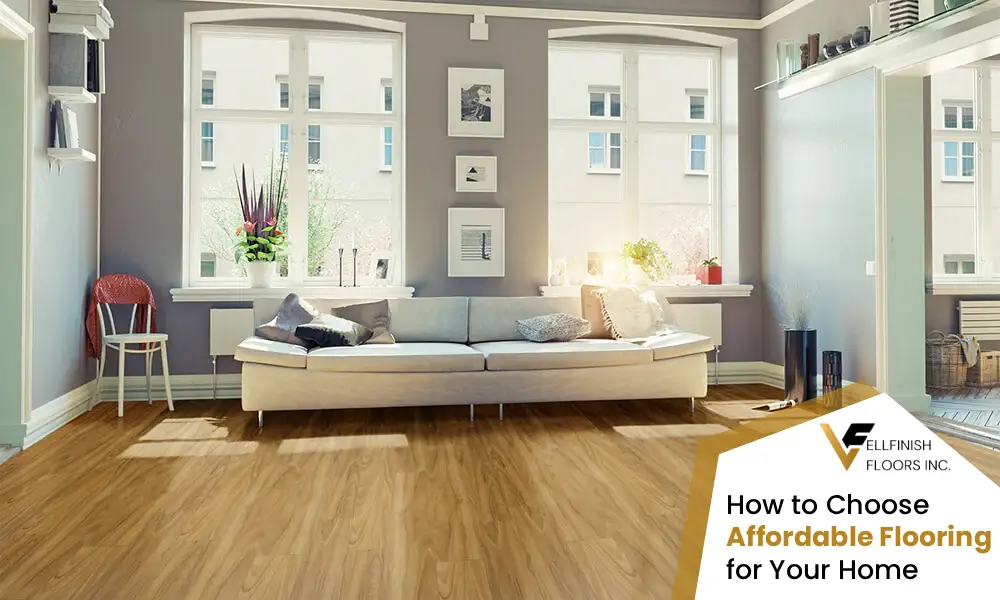How to Choose Affordable Flooring for Your Home

In terms of renovating or building a domestic, flooring plays one of the maximum essential roles in defining the look, comfort, and standard sense of your area. However, locating floors this is both elegant and lower priced may be a challenge. The best news? With today’s wide range of substances, finishes, and set up options, you may obtain the ideal balance between beauty, durability, and cost-efficiency.
In this guide, we’ll stroll you through the whole thing you want to realize to Choose Affordable Flooring for Your Home, from expertise your lifestyle desires to evaluating materials, fees, and maintenance requirements.
1. Apprehend Your flooring desires
Before exploring flooring alternatives, it’s important to determine what you really want. Each area in your property has specific necessities, and identifying those early assist you to keep away from expensive mistakes.
Keep in mind the following elements:
- Foot site visitors: regions like residing rooms, kitchens, and hallways revel in heavy foot visitors and need durable floors.
- Moisture tiers: bathrooms, laundry rooms, and basements require water-resistant or waterproof substances.
- Comfort: Bedrooms and family areas benefit from tender, warm floors like carpet or cork.
- Renovation: a few flooring need common cleansing and sealing, even as others are surely renovation-loose.
- Aesthetic desire: reflect onconsideration on the general design of your property—current, rustic, traditional, or modern-day—and pick out flooring that enhances it.
Whilst you check these factors prematurely, you may slim your options to those who provide the first-class blend of practicality, style, and affordability.
2. Set a sensible budget
Earlier than shopping for floors, it’s critical to define your budget—consisting of not best the cost of substances however also set up, underlayment, trims, adhesives, and upkeep.
Breakdown of floors fees:
- Low-value range: $2 hundred according to sq. Feet. (vinyl, laminate, ceramic tile, basic carpet)
- Mid-variety: $3 per sq. Toes. (engineered wooden, luxurious vinyl, better-high-quality tiles)
- High-stop: $4 consistent with sq. Feet. (hardwood, herbal stone, premium engineered substances)
Remember the fact that installation can account for 30–50% of the overall cost. DIY-pleasant substances like laminate or peel-and-stick vinyl can help you save considerably.
Pro Tip:
Always purchase 5–10% extra floors to account for waste, slicing, and future maintenance.
3. Evaluate the most cheap floors alternatives
Now which you realize your wishes and finances, it’s time to discover the fine low priced floors materials available. Below is an outline of the most popular options, in conjunction with their benefits and disadvantages.
A. Laminate floors
Fine for: living rooms, bedrooms, hallways
Laminate floors is one of the maximum value-effective picks for owners who want the advent of hardwood with out the rate tag. It’s made from composite wooden pressed together and blanketed with a photographic image layer that mimics wood, stone, or tile.
Pros:
- Cheaper and clean to install (DIY-friendly)
- Extensive variety of styles and textures
- Scratch-resistant and durable
- Clean to clean and hold
Cons:
- Can be noisy underfoot without underlayment
- Susceptible to water harm if not sealed properly
- Cannot be refinished once worn
B. Vinyl floors (Sheet, Tile, or Plank)
Nice for: Kitchens, lavatories, laundry rooms
Vinyl flooring has developed drastically over the years, and modern luxury Vinyl Plank (LVP) and comfort Vinyl Tile (LVT) options can replicate the look of hardwood or stone at a fraction of the value.
Pros:
- One hundred% water-proof (notable for moisture-prone regions)
- Durable and stain-resistant
- Smooth and comfy underfoot
- Easy DIY installation alternatives
Cons:
- Can fade underneath direct sunlight
- Decrease-exceptional options can also dent or tear
- No longer as green as natural substances
C. Ceramic and Porcelain Tiles
Nice for: toilets, kitchens, and entryways
Tiles remain a classic choice for owners who cost durability and a smooth, polished look. Ceramic tiles are normally less expensive, even as porcelain offers higher electricity and water resistance.
Professionals:
- Extremely durable and long-lasting
- Water- and stain-resistant
- Low preservation
- Wide variety of colorations and designs
Cons:
- Cold and difficult underfoot
- Installation may be time-consuming
- Grout lines require normal cleansing
D. Engineered wooden flooring
Great for: dwelling rooms, bedrooms, eating areas
Engineered timber presents the splendor of real wood with added balance and moisture resistance, thanks to its layered production. It’s a notable compromise among luxurious and affordability.
Professionals:
- Looks and feels like actual hardwood
- Easier to put in than strong wooden
- Immune to warping and humidity changes
- May be sanded and refinished (some varieties)
Cons:
- Greater luxurious than laminate or vinyl
- Liable to scratches from heavy fixtures
- No longer best for excessive-moisture areas
E. Carpet floors
Excellent for: Bedrooms, living rooms, and family regions
Carpet stays a favorite for owners who prioritize comfort and warmth. It’s one of the maximum low-priced floors substances, specifically for large areas.
Pros:
- Soft, secure, and heat underfoot
- Reduces noise and improves insulation
- Wide kind of hues, textures, and patterns
Cons:
- Can stain and trap dust without difficulty
- Calls for everyday vacuuming and cleansing
- No longer ideal for people with allergies
F. Cork and Bamboo floors
Satisfactory for: Eco-conscious homeowners
Cork and bamboo are natural substances that offer a completely unique appearance, comfort, and sustainability blessings at an affordable price.
Execs:
- Renewable and eco-friendly
- Smooth and quiet underfoot
- Obviously immune to mildew and mildew (specifically cork)
Cons:
- Prone to scratches and dents
- Can fade in daylight
- May also require sealing for moisture resistance
4. Keep in mind sturdiness and renovation prices
Even as affordability is crucial, don’t ignore lengthy-term durability and renovation. A cheap ground that needs common upkeep or substitute can price more through the years.
Durability contrast (approximate lifespan):
- Vinyl floors: 10–20 years
- Laminate floors: 15–25 years
- Engineered wooden: 20–forty years
- Ceramic/Porcelain Tile: 25–50 years
Carpet: 5–10 years
Pick out a cloth that aligns along with your family’s way of life. For instance, if you have kids or pets, sturdiness and scratch resistance can be key priorities.
5. Set up options: DIY or professional
Installation can notably effect your total floors cost. If you’re looking to save money, DIY set up can be an exceptional alternative—particularly with substances like laminate, vinyl planks, and peel-and-stick tiles.
However, professional installation guarantees better completing and sturdiness for complicated substances like tile or engineered wooden.
DIY-pleasant flooring:
- Laminate floors
- Vinyl planks/tiles
- Peel-and-stick carpet tiles
- Expert installation endorsed for:
- Hardwood or engineered wood
- Ceramic and porcelain tiles
- Natural stone
Usually request fees from multiple installers to evaluate expenses earlier than making your selection.
6. Examine the lengthy-time period price
Low-cost flooring doesn’t necessarily imply the cheapest in advance. Do not forget lifestyles-cycle expenses, which includes:
- Preservation and cleansing components
- Restore or replacement costs
- Resale value (a few flooring will increase home price)
For instance, engineered wooden and tile might cost extra to begin with however ultimate plenty longer and enhance your property’s price—making them a smart investment.
7. Layout and Aesthetic issues
Floors defines your house’s ecosystem. Even when operating with a decent budget, you don’t have to compromise on style.
Design pointers:
- Use lighter shades to make small rooms appearance large.
- Strive timber-look vinyl or laminate for a heat, natural feel.
- Use contrasting grout with tiles for a present day look.
- Combine materials—like vinyl within the kitchen and carpet within the bedroom—for practicality and luxury.
Cutting-edge floors technology allow price range-pleasant materials to intently replicate the look of wooden, marble, and stone.
9. Sustainability and eco-friendly choices
In case you’re environmentally aware, search for eco-friendly floors options like bamboo, cork, reclaimed timber, or recycled tiles. Many modern vinyl and laminate floors are also available in low-VOC (volatile organic compound) formulations, which improve indoor air nice.
9. Pointers to save cash on flooring
Right here are some realistic strategies to live inside your finances:
- Buy in bulk: suppliers regularly offer discounts for large portions.
- Shop at some stage in sales: look for clearance or stop-of-season deals.
- Mix and in shape: Use premium materials most effective in visible areas and lower priced ones somewhere else.
- DIY set up: save hard work prices wherein possible.
- Reuse present subfloor: If in excellent situation, you can installation new floors on top.
Small smart picks can cause big savings with out sacrificing style or fine.
Conclusion: Choose Affordable Flooring for Your Home
Choose Affordable Flooring for Your Home is all about stability—between fee, durability, renovation, and aesthetics. Take time to analyze distinctive materials, request samples, and compare expenses. Remember, the right floors no longer simplest complements your home’s beauty but additionally contributes to comfort and lengthy-term fee.
Whether or not you pick laminate for its affordability, vinyl for its versatility, tile for its sturdiness, or engineered timber for its elegance, your perfect floor is out there—prepared to carry life, warmth, and man or woman to every room.


